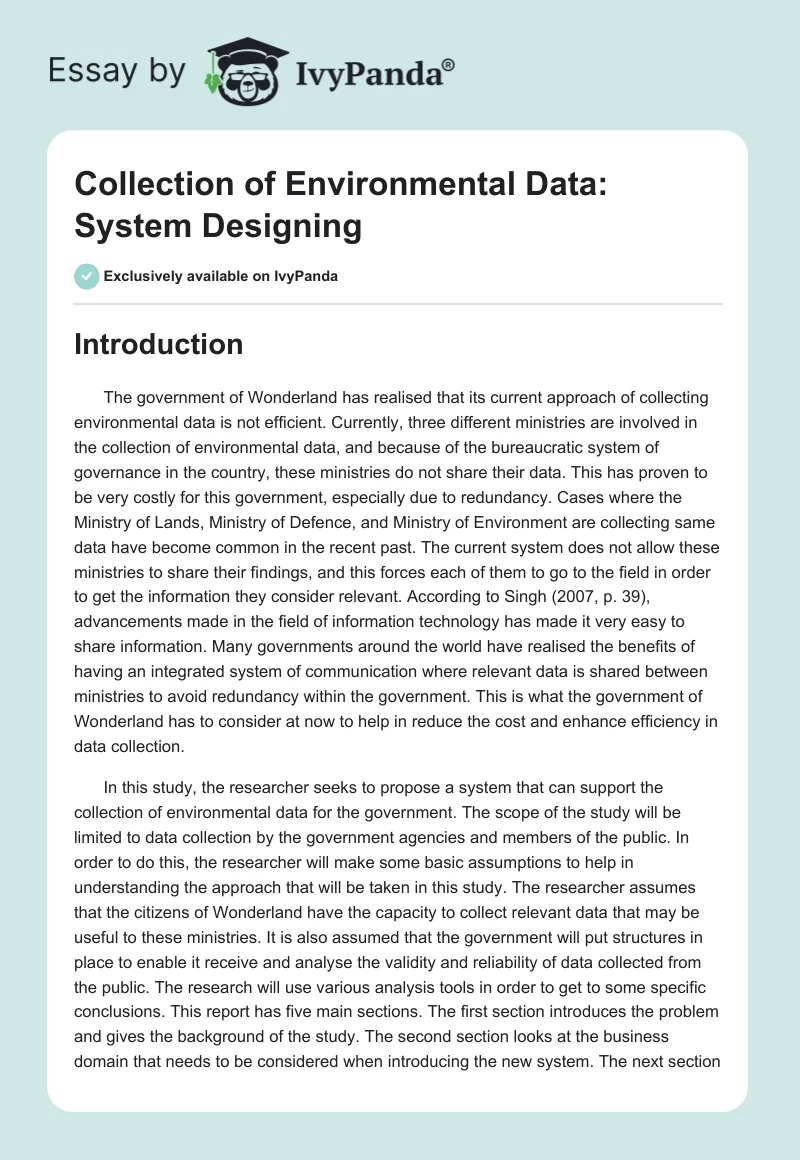Introduction
The government of Wonderland has realised that its current approach of collecting environmental data is not efficient. Currently, three different ministries are involved in the collection of environmental data, and because of the bureaucratic system of governance in the country, these ministries do not share their data.
This has proven to be very costly for this government, especially due to redundancy. Cases where the Ministry of Lands, Ministry of Defence, and Ministry of Environment are collecting same data have become common in the recent past. The current system does not allow these ministries to share their findings, and this forces each of them to go to the field in order to get the information they consider relevant.
According to Singh (2007, p. 39), advancements made in the field of information technology has made it very easy to share information. Many governments around the world have realised the benefits of having an integrated system of communication where relevant data is shared between ministries to avoid redundancy within the government. This is what the government of Wonderland has to consider at now to help in reduce the cost and enhance efficiency in data collection.
In this study, the researcher seeks to propose a system that can support the collection of environmental data for the government. The scope of the study will be limited to data collection by the government agencies and members of the public. In order to do this, the researcher will make some basic assumptions to help in understanding the approach that will be taken in this study. The researcher assumes that the citizens of Wonderland have the capacity to collect relevant data that may be useful to these ministries.
It is also assumed that the government will put structures in place to enable it receive and analyse the validity and reliability of data collected from the public. The research will use various analysis tools in order to get to some specific conclusions. This report has five main sections. The first section introduces the problem and gives the background of the study.
The second section looks at the business domain that needs to be considered when introducing the new system. The next section looks at the business requirements that the new system will need to be operational. The fourth section looks at how the stakeholders will manage change that comes with the new system. The final section concludes the report.
Business Domain Analysis
It is clear that the current strategy that is used at this firm is not efficient given the current environmental factors. The case presented above demonstrates that it is the right time to redefine the strategy in order to have a new system that is not only time conscious, but also less costly. In this section, the research will focus on strategy, organisational, and stakeholders’ analysis in order to understand how this system may be applicable.
Strategy Analysis
According to Ball and Kiel (2004, p. 81), efficiency in data collection is very critical in the current society. Various environmental factors are changing very rapidly, and for an organisation to be successful in data collection, it is necessary to have a way of accessing current data, analysing it, and presenting the information for consumption within the shortest time when it is still relevant. Stevens and D’Hondt (2010, par. 1) says that information is the tool that many organisations are currently using to manage some of the emerging challenges in the environment. However, it can only be useful if it is made available to the relevant authorities at the right time.
In this new strategy, the Victorian government will eliminate the current bureaucratic system where various ministries do not share their data and in its place establish an integrated information management system. The new integrated system will define the role of each ministry in data collection, analysis, and storage of information.
The current system where each ministry is collecting its own data on the same environmental factors will be eliminated. In this new system, the Ministry of Environment will take the responsibility of collecting and analysing data from the environment. Once this is done, the information will be made available to all the three ministries so that relevant actions can be taken. The Ministry of Defence and Lands will also need to share relevant information with the Ministry of Environment based on the information they are offered.
In order to create an environment that will allow these ministries to share relevant information, the management will need an appropriate data management system. The government may choose Master Data Management System, which will allow it to use multiple domains. However, the current requirements will require the government to use Integrated Electronic Data Management System.
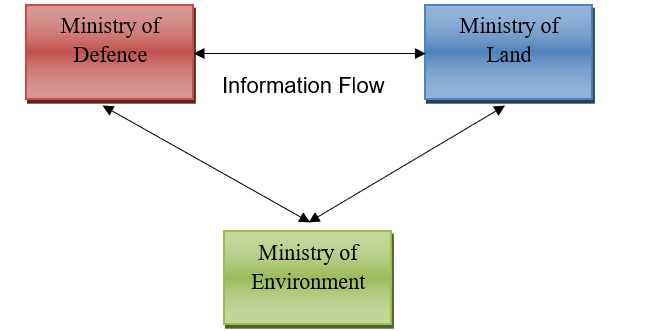
As shown in figure 1 above, the government will develop an open communication system between the ministries where information will flow easily from one ministry to the other in order to improve efficiency. The electronic system eliminates the need to move from one office to the other transferring physical files. The ministries will share information in the database electronically. Whenever there is a need for the Department of Defence to access information that is available to the database of the ministry of government, it will only need to send a signal to the database and access will be permitted. This will eliminate redundancy.
Before any of the ministries can collect data from the field, they will need to check with the other ministries to confirm that such data is not available and that there are no programs underway to collect such data. This new system will also allow members of the public to share data they collect with the government. Crowdsourcing technologies will be the best approach because it will enable the public to share this information view their mobile phones.
However, the relevant ministries will need to verify such data before they can be availed in the database. Engaging the public in collection of environmental data will help the government to identify some of the issues that the ministries may ignore. It is necessary to use SWOT Analysis in order to understand the issues associated with Integrated Electronic Data Management System.
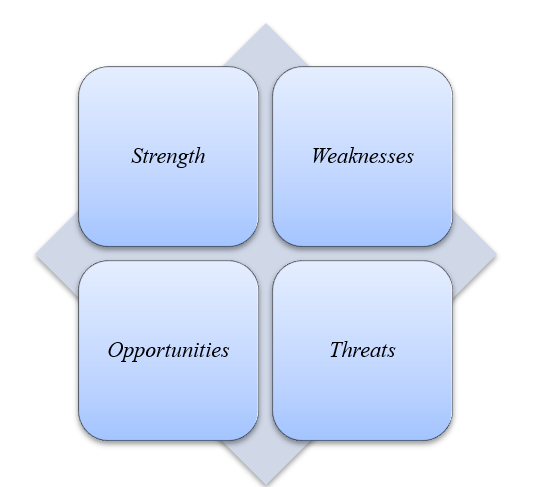
This system has a number of factors that may be considered its strength in enhancing management of information. This system will eliminate the use of physical files within these ministries. If the ministries have physical files, they will need to convert them into electronic files and store them in the electronic databases. It will help eliminate cases of lost or damaged files that are always common when using physical files. This system will reduce the time taken to retrieve stored data.
These departments will be able to share files without having to send their staff to collect the physical data. When the ministries use this integrated system, they will easily share new knowledge that may help them address various issues in a better way. For instance, if the Ministry of Defence conducts a research that may be relevant to other ministries, the information will be available for them, eliminating the need to conduct a similar research. It is the best strategy that will help in fighting the current bureaucratic system that is currently witnessed at this firm.
The Integrated Electronic Data Management System has a number of weaknesses that should be addressed by the three ministries very carefully. It is easier to corrupt electronic data that is available online, than to corrupt information in the physical files. It means that in case some of the internal players within the ministries are aiming at achieving some personal gains, they can easily manipulate such electronic data to their favour.
Another weakness is that the system needs experts who will manage it. Unlike the shelves that require semi-skilled labour, the system require an IT expert who will be able to debug the system, monitor activities of people as they access the system, and ensure that external threats are not allowed into the system. If the system breaks down, there may be a serious confusion within the departments. The same confusion may be experienced if the files are corrupted.
The Integrated Electronic Data Management System comes with a number of opportunities that these ministries should exploit. When using this system, the time used in managing data will be reduced significantly. This will offer the affected staff more time to explore other activities. The system will create a room for research and development within the ministry. With information readily available, these ministries can enhance their research into some of the emerging issues, which are relevant to them.
The use of technology also expands the skills and capabilities of the employees in terms of information management. Technology simplifies the process, and creates an opportunity to learn more about data management. The use of this system will allow individual employees to engage in innovative ideas, which may be very important to the ministries. According to Ball and Kiel (2004, p. 143), the current competitive world highly cherishes creativity and innovativeness. However, employees can only be creative at their work when they have enough time to try new things.
It is important to note that the system may come with a number of threats that may affect these ministries in various ways. Advancement in technology, especially when it is engineered by cybercriminals, may pose serious threats to these ministries. The Ministry of Defence is always under threat from the international terrorists who may be planning attacks on the country. When the ministries fail to protect the new system, it may be the get way for the criminals to access information they need from the ministry.
The system may also suffer from attacks by malware. This may have serious negative impacts on the information stored in the system. The system may also leak vital information of the ministries, especially if the database is accessible to people who have ill motives. These three ministries will need to develop a system that has the capacity to overcome these challenges.
Organisational Analysis
In order to achieve the desired results when using Integrated Electronic Data Management System, these three ministries will need to be managed as a single entity from the perspective of data management. The three are independent institutions with very different mandates. However, Kumar (2013, p. 74) says that it is easy to manage information in a harmonious manner if the departments involved have a common organisational behaviour.
Organisational behaviour has become one of the most important areas of management because of its relevance in improving the performance of the organisations. Several scholars have defined organisational behaviour in various ways. Thierauf (1999) defines organisational behaviour as “The study of human behaviour in organisational settings, the interface between human behaviour and the organisation, and the organisation itself.” This scholar observes that the way an individual would behave as an independent entity is very different from his or her behaviour when acting within an organisation (Klein 2012, p. 52).
When acting on behalf of a group or acting within a group, there are some factors that would have a sharp influence on one’s behaviour. This would make the behaviour different from that when one is acting as an individual and when is with the family or friends. According to Maier (2007, p. 20), organisational behaviour defines the organisational performance. The manner in which the members of a given organisation behave will always define the way they address their duties. With the current competitive world market, many organisations are forced to find ways of developing the appropriate organisational behaviour that promotes teamwork, innovation, and the desire by the employees to push an extra mile whenever they are addressing their assigned duties.
When using Integrated Electronic Data Management System, the three ministries will need a common organisational behaviour that will help in various ways. According to Zwass (2002, p. 32), one of the best ways of detecting intruders in a database is to monitor their behaviour. Erratic behaviour within the database is always an indication that someone is trying to access information without permission. The Ministry of Environment, Ministry of Defence, and the Ministry of Lands will need to take their employees through an elaborate training program on how to use the system.
During the training process, the employees that are directly involved with the management of the database at the three ministries should be trained to adopt a common organisational behaviour. This way, it will be easy to detect when one is accessing the database from the Ministry of Defence and the kind of information he or she may be looking for at that time. As Singh (2007, p. 21) advises, the three ministries may develop three domains managed from three different locations. All the information relevant to the ministry of Defence, including classified information that is not relevant to any other ministry for security reasons, should be managed at the headquarters of this ministry.
The same case will apply to the other two ministries. Whenever the Ministry of Lands or the Ministry of Environment needs any information that is within the domain of the Ministry of Defence, they will need to send a signal and a code that will be used to allow them access the specific information they need. Developing a common culture will be very important when it comes to enhancing the security of the system. The database manager at the Ministry of Defence will find it easy to detect strange movements by people who are not accustomed to the normal behavioural pattern of the legal members of the system. This will enhance the capacity to protect the information in the system (Environment Agency 2014, par. 1).
The organisational structure will be defined by the management structure of the three ministries. When defining this structure, it is important to note that the ministries will need to embrace a pattern that will make their representatives feel valued. The three ministries will assume the same rank, with none of them being regarded as superior to others in the context of data management. This will help in eliminating unnecessary tensions that may develop in case this is not taken care of as early as possible.
The three ministries will constitute the top management unit of this new information management system. The managements will need to ensure that they identify people with the right capacity to hold various positions in the actual management of the data within the system. There should be a close coordination between these employees and the top management unit, as shown in the diagram below.
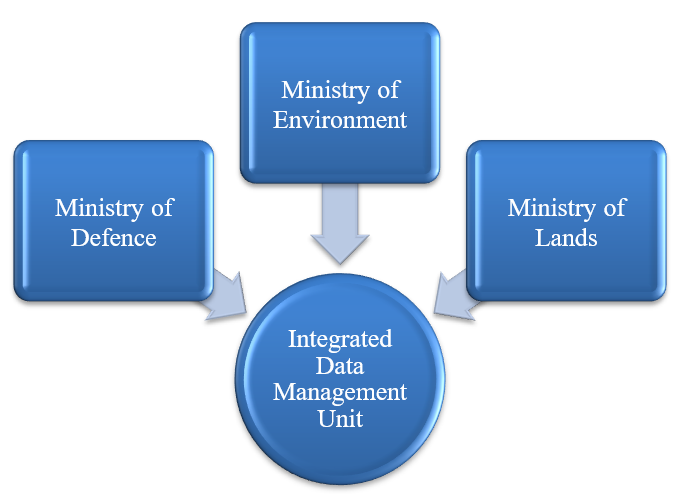
As shown in figure 3 above, the three ministries will be sharing the data management unit, but within the unit, each of the ministries will have its own domain that is managed at their own headquarters. However, the individual employees working within the unit at each of the ministries’ headquarters need to maintain a close coordination in order to address any issue that may arise.
Stakeholders’ Analysis
The stakeholders that will be involved with the new system will be drawn from the Ministry of Environment, Ministry of Labour, and Ministry of Land. The Ministry of Environment will primarily do the role of collecting and analysing environmental data. This ministry will have the central responsibility of collecting, analysing and presenting data to all other agencies of the government. The ministry will make the information available through its database. The interest that the ministry has in this field makes it the major player that will influence data management process in this new system.
The Ministry of Defence will be an active consumer of the information that is available in the database. However, it will also have the mandate to collect specific data in close coordination with the Ministry of Environment. It will be assigned the responsibility verifying some critical data that is relevant to the homeland security. The Ministry of Lands will also be a major consumer of the information available in the database. It will have the mandate to collect specific data that focus on land issues. The public will also play a role of collecting data and making it available to the relevant ministry through their mobile phones. They also have the mandate to inquire about relevant information within the database. The RACI Matrix below shows how each of the ministries should be responsible for this new information management system.

The database managers from the three ministries will be directly involved in the daily management of the data. Each will be assigned different tasks depending on the ministry one is working for at any given time. Important decisions about the system will have to come from the top management unit in these three units. The database managers are accountable to this management unit. Whenever the database managers are faced with a challenging issue affecting the system, they are expected to consult their seniors at their respective ministries so that an acceptable solution may be found.
Similarly, these employees will need to keep their superiors informed about various events, especially about the major opportunities and threats that may need the attention of the top management unit. In this section, the researcher has critically analyzed business domain for the new system. The following section will focus on business requirements for this system to be functional.
Business Requirements Analysis
At this stage, it is important to conduct a business requirement analysis in order to understand what it will take to make this system work successfully. The researcher will analyse business requirements specifications, business system modelling, and business process modelling.
Business requirements specification
In order to run properly, this new system will require a number of items from each of the three ministries involved. This system will need a database. This may be in the form of a mainframe computer that will be used to store all the sensitive data of the firm. This may be located within the Ministry of Defence for the purpose of security. The other two ministries will need minor databases that can easily be supported by personal computers.
Each of the employees responsible for data management will need a personal computer at their workstations in order to process, store, or retrieve the data. In order to have a functional system, it is important to define the functional and non-functional requirements of this new system. The table below identifies these requirements.
Table 1: Functional and Non-functional requirements.
The functional requirements identify what the new system is expected to do, while the non-functional requirements identify how the new system will work.
Business systems modelling
In order to develop a holistic view of the business situation under investigation, it will be necessary to conduct the business system modelling relevant to this case. The sections above have identified the main requirements needed to make this system functional. In this section, it will be necessary to determine the justification for the requirements by looking at how they will be put into use in the normal running of the system. CATWOE framework is a very vital tool that can help in the critical analysis of the business case in order to determine the relevance of the resources mentioned in the section above.
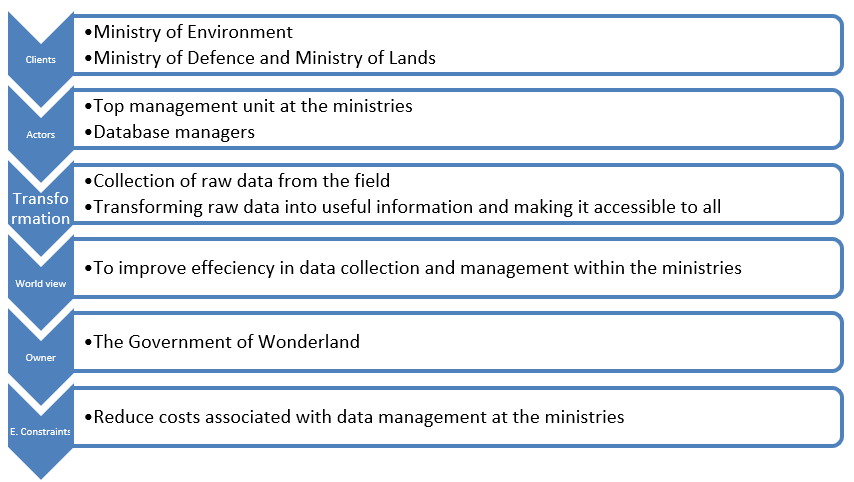
As shown in figure 6 above, the clients in this new system are the three ministries, which are trying to eliminate costs by integrating some of their processes. They will benefit from this system because the integrated system will help in eliminating redundancy, encourage teamwork, and promote innovativeness among their employees. The main actors here are the individuals who will be responsible for decision-making processes and the management of the system. The top management unit at each of the ministries will form the top management unit. They will define the manner in which various activities will be conducted when using the new system.
The second group will be the technocrats who will be managing the database. These database managers will need the hardware and the software discussed above in order to run the system. The mainframe computer will allow them to store large amounts of data for the three ministries, while the personal computers will allow them to conduct their daily routine without the need of visiting the location of the mainframe computer. Internet services will be needed to make this possible.
The transformation, as shown in this model, will involve analysing the raw data by various departments within the three ministries. The worldview or the wider picture of using this system is to eliminate unnecessary costs and time wastage when the three ministries are forced to collect same data. By integrating their information management system, one of the ministries will be responsible for collecting and analysing such data and making it available to all other relevant ministries. This integration will also enhance the security system used by the ministries to protect their data. Instead of splitting the resources to the three ministries, the government will now focus on a single system that saves the three ministries. This will make it possible to purchase the sophisticated tools that will enhance the security of the database.
The government of Wonderland is the owner of the entire system. As the owner of the system, this government has realised that it will cost less if these ministries integrate their information management system in order to avoid cases of redundancy. The environmental constrains in this case are some of the factors that made it necessary to use this system. The changing pattern of technology has brought various challenges in the data management process. The government, therefore, considered it appropriate to integrate its system to lower the cost and focus its resources in enhancing its communication strategies. Another environmental constrain that motivated the government to consider using a new system is the increasing relevance of the ministries to coordinate in their operations.
In the past, the government has had a bureaucratic system where each of the ministries was run as independent entities that had nothing to share. The Ministry of Lands, Ministry of Defence, and the Ministry of Environment worked independently without sharing knowledge. This may not be advisable in the current society where information has become very critical. According to Gupta (2006), information in the current society has become so critical that organisations are forced to define a superior approach of managing their databases. The best way that this government can achieve success in managing information will be through integrating its systems and sharing relevant data for the benefit of all the ministries. These ministries support each other in one way or the other.
It is, therefore, necessary if they coordinate closely to face some of the environmental challenges as a unit. Integrating the system will also eliminate any possible suspicion that may exist between these ministries. When these ministries work independently, there will be some form of suspicion, especially when they release conflicting results on the same issue. This will affect the working relationship among these ministries. However, this system offers a perfect solution to this problem. These ministries will now work together in their research, and any variations can be addressed internally before the result is released. This will boost the working environment amongst these three ministries.
When managing the system, it is important to understand how various processes will be managed in order to avoid confusions or misunderstandings. According to Tan and Tan (2010, p. 46), it is important to have a clear pattern of accessing the information in the database. Every person involved in the process should understand this standard approach in order to avoid any form of misunderstanding, or cases of allowing unwanted visitors into the site. To help at this stage, BAM notations may be helpful in processing the transactions within the system.
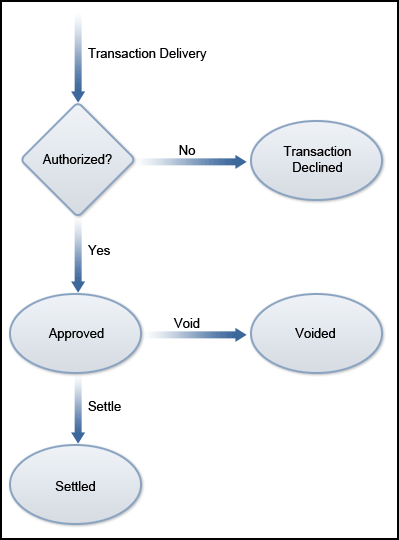
As shown in figure 7, when the database manager receives a delivery request for a transaction to be conducted in the database, the first activity will be to determine of the transaction and the person responsible for it have the authority to do so. If the person has not permission, the transaction will be declined immediately and the reason for the decline will be delivered. In case the transaction and the person have been authorised, then the next step will be to determine if the transaction is approved. If it is not approved, the transaction will be considered void. It will be suspended, waiting for the approval from the relevant authority. If it is approved, then it will move to the final step of getting it settled. This vigorous process of checking and counter-checking will eliminate cases of unauthorised access into the system.
In order to visualise the business system function, a UML use case diagram may be necessary at this stage. The figure below shows UML use case diagram for the.
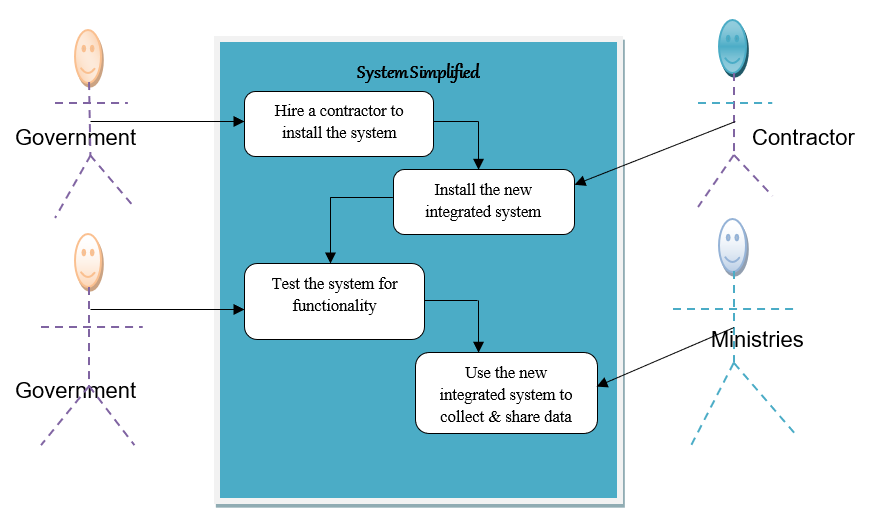
As shown in figure 8 above, the government will have the responsibility of hiring a contractor who will be responsible for the installation of the new integrated system. This will be done through a competitive bidding, and the company that has the best capacity to develop this new system will be given the tender. When the contractor has completed the installation process, the government will test the system to check if it can offer the desired services. If some adjustments are needed, the government will instruct the contractor to make these adjustments. In case it meets all the conditions, the three ministries will officially take control of its management.
Business process modelling
The above analysis represents a clear transition from ‘as-is’ process to a ‘to-be’ process. currently, the government of Wonderland is using a bureaucratic system that do not allow various ministries to share vital information that may help in addressing challenges that they face due to changing environmental factors. The government is forced to spend a lot because different ministries perform similar tasks which results into duplication of information that already exists. There is need to change from this ‘as-is’ process which is costly, time consuming, and ineffective way of collecting environmental data, to a ‘to-be’ process which embraces the use of technology.
In order to do this, the government has a role to play. The UML use case diagram above clearly highlights what the government is expected to do in order to make this a reality. It needs to install the hardware and software that is needed by these ministries. Once this is done, the ministries will then change from the current system to a new system that is efficient and less costly. This section has identified all the necessary requirements that this system will need. The next section focuses on how to manage change when this new system is introduced.
Managing Changes
According to Gupta (2011, p. 59), managing change is one of the most challenging tasks in large organisations such as in government ministries. People are always comfortable working with established structure that they understand. For this reason, it is expected that the news about changing the entire system of data management at the three ministries will come as shocking information to most of the people involved. The managers and junior employees are used to the current manual system and they feel that the new system may disrupt the normal operations of their ministries. Moreover, these people have gotten used to a bureaucratic system where each of the ministries operates independently. The fact that these ministries will now be working in close coordination will create some discomfort among some of the people, especially the commanders in the Ministry of Defence.
Tan (2001) says that the best way of managing change is to actively engage the concerned parties in the process of initiating change. In this context, the government can initiate programs in the relevant ministries that would challenge the existing system. The commanders in the Ministry of Defence and the senior officers in the ministries of land and environment should realise that their current structures are obsolete and very ineffective in managing the current forces. This will make them initiate programmes that will help in addressing the identified weaknesses. It is at this stage that the government should jump in with the proposal of integrating the data collection and management system of the three ministries. This can best be demonstrated using Kurt Lewin’s Unfreeze-Change-Unfreeze Model shown below.

As shown in figure 9 above, the first step will be to unfreeze. This involves a series of activities that will address the fear that people have towards change. It will make them embrace change as an inevitable move towards a better future. The next step would be to initiate change, which in this case will be the introduction of a new data management system. When this is done, then the top management will start a process known as refreezing. At this stage, the management will be addressing the challenges faced by the users of the new system and making it easy for them to use the system. The strategy will be used in managing change at this firm. This section of the paper has highlighted strategies that the government and all other stakeholders may consider using in order to manage change.
Conclusion
This study reveals that it is the right time for the government of Wonderland to introduce a new system of collecting data to replace the current one, which has become ineffective. The government has been spending a lot in activities that are redundant because of its bureaucratic system that limits the ability of the ministries to share data. The Ministry of Environment, Ministry of Defence, and Ministry of Land will need to integrate their data collection system so that they can share their knowledge when this is necessary. Using Integrated Electronic Data Management System in collection of environmental data will enable these ministries coordinate closely and share information that is relevant to their ministries.
This will reduce the cost of data management because everything will be done at one point. The main limitation of this strategy is in the fact that it will require IT experts to manage the system. These experts may demand higher salaries than the semi-skilled labour used in managing the files. The initial cost of installing this new system may also be high.
Ethically, this new system will lead to the retrenchment of some of the employees in the three ministries because the work will be condensed and conducted using technology. This system will be sustainable because its cost of maintenance will keep going down, while its output will be higher than that of the current system. Although the proposed system will be able to meet the current needs, there is room for improvements. In future, the government should consider developing an integrated information management system for all its ministries.
List of References
Ball, M & Kiel, J 2004, Healthcare Information Management Systems: Cases, Strategies, and Solutions, Springer New York, New York.
Environment Agency 2014, Southern Water fined for polluting the sea and a Kent watercourse. Web.
Gupta, H 2011, Management information system: (an insight), International Book House, New Delhi.
Gupta, U 2006, Management information systems: A managerial perspective, West Publishers, Minneapolis.
Heijden, J 2009, Designing management information systems, Oxford University Press, Oxford.
Klein, B 2012, An introduction to IMS: Your complete guide to IBM information management system, Pearson Education, London.
Kumar, V 2013, Fundamentals of pervasive information management systems, Cengage, New York.
Maier, R 2007, Knowledge management systems: Information and communication technologies for knowledge management, Springer Berlin, Berlin.
Oz, E 2009, Management information systems, Thomson/Course Technology, Boston.
Singh, S 2007, Information system management, APH Publishing, New Delhi.
Stahl, B 2004, Responsible management of information systems, Idea Group Publishers, Hershey.
Stevens, M & D’Hondt, E 2010, Crowdsourcing of Pollution Data using Smartphones. Web.
Syed, M 2001, Design and management of multimedia information systems: Opportunities and challenges, IGI Global, Hershey.
Tan, J & Tan, K 2010, Adaptive health management information systems: Concepts, cases, and practical applications, Jones and Bartlett Publishers, Sudbury.
Tan, J 2001, Health management information systems: Methods and practical applications, Aspen Publishers, Gaithersburg.
Thierauf, R 1999, Knowledge management systems for business, Quorum Book, Westport.
Zwass, V 2002, Management information systems, Brown, Dubuque.

